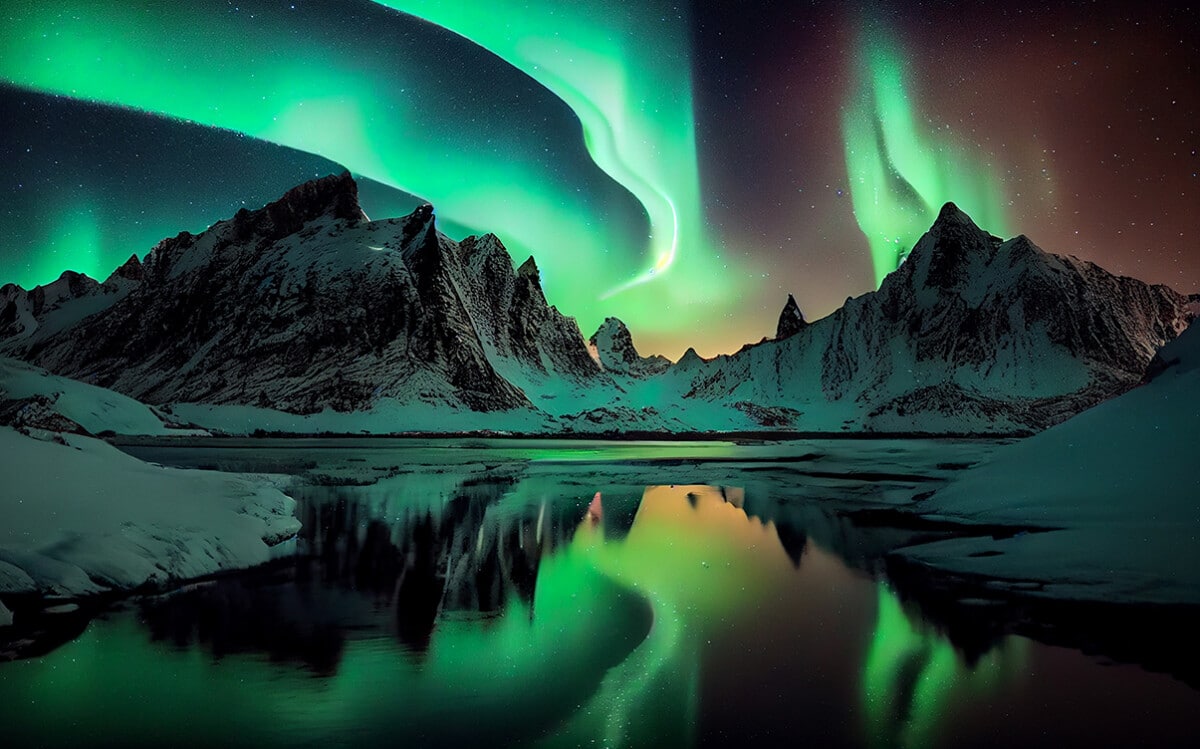The Norse peoples and Vikings held the northern lights (aurora borealis) in both reverence and awe. Observing the vibrant, dancing lights across the polar skies must have been a mesmerizing sight for these early Norse people, and the northern lights soon became woven into the fabric of myth and legend.

For the Norse peoples the world was full of supernatural elements, with the natural phenomena often imbued with divine or mystical meanings. The northern lights were no exception. The sky was associated with Gods and spirits, and the lights represented a portal between the earthly and the divine. According to some Norse interpretations, the aurora borealis was seen as a powerful bridge between the mortal world of Midgard and the otherworldly realms of the Gods, including Asgard.
For the Vikings the Northern Lights often meant that Odin had sent the Valkyries to retrieve the souls of fallen warriors. They believed that the aurora was light reflected from the Valkyries' battle armor.
When the Northern Lights announced the Valkyries’ arrival, it was cause for celebration, for it was a great honor to die in battle, and an even greater honor to be chosen by the Valkyries to become warriors in Odin's personal army. It was thought that only the very best soldiers were selected by Allfather Odin and allowed to enter Åsgard, his realm.
Other interpretations saw the lights as the work of Freyja, the Goddess of magic, love, fertility, and beauty, who was also linked to the dead. Freyja’s hall is located in the realm of Folkvangr, where she welcomes half of the worthy fallen warriors after battle, while Odin claimed the other half. The aurora borealis, in this sense, was seen as an expression of Freyja’s sorrow for the fallen or as her magical light guiding them to her hall. These interpretations reinforced Freyja’s significance in Norse religion and provided the Norse peoples with a more tender and compassionate view of the northern lights.

In the other hand, the Sami, Norway's indigenous people, did not believe that the Northern Lights were a sign of joy. For them, the celestial phenomenon was instead a ghostly veil where the light represented the souls of the dead.
These souls were not to be disturbed – one needed to avoid looking at them, talking, waving, whistling or singing, because if the light sensed your presence, it might snatch you and carry you off into the sky. More macabre legends believed that the Northern Lights could cut off your head if you were not careful.
The belief that the light was a manifestation of dead souls was shared by indigenous people in Greenland and North America as well. In Greenland it was thought that these were the souls of children who did not survive birth. Native Americans believed that they were the souls of deceased relatives and wild game killed by hunters.
The northern lights also held practical significance. As seafarers, the Norse peoples were skilled in reading the stars and natural cues to navigate. Although the aurora borealis doesn’t help with precise navigation, these skilled sailors associated it with northern regions and could interpret it as a reminder of the vast, uncharted territories beyond. Such beliefs likely played into their adventurous spirit, encouraging them to explore new lands and expand their influence across the North Atlantic.
Swedish fishermen often scanned the sky and looked for the Northern Lights before going fishing. They saw the light dancing across the sky as a reflection of massive shoals of fish. Thus, the light, to them, meant that they would land a huge catch.
The Danes believed that the light was caused by swans that had flown too far north and got stuck in the ice. The light was created when the swans had broken free from the ice, and their wings spread shards of ice into the sky, which in turn refracted amazing light patterns that became the Northern Lights.
The Finns also believed the light was caused by animals. They call the phenomenon "revontulet" which directly translated means fox fire. This name derives from an ancient Finnish myth about some mythical fire foxes. They were not actually aflame and they could not fly, but as these foxes ran through the landscape, their tails were supposedly dragged atop mountain rock and natural terrain and thereby, by friction, created sparks, which were then propelled upwards and set fire to the sky.

Throughout the northern realms the aurora borealis meant many different things for different peoples, but the beautiful spectacle was never ignored. Even though today we can scientifically explain the phenomena, the northern lights will always remain magical in our hearts.
References
Crossley-Holland, Kevin. The Norse Myths. Pantheon, 1981. ISBN 0394748468.
Davidson, Hilda Roderick Ellis. Gods and Myths of Northern Europe. Penguin Books, 1990. ISBN 0140136274.
Price, Neil. Children of Ash and Elm: A History of the Vikings. Basic Books, 2020. ISBN 0465096989.















Comment (1)
Thank you for this information, I have found it very interesting and hope to learn more